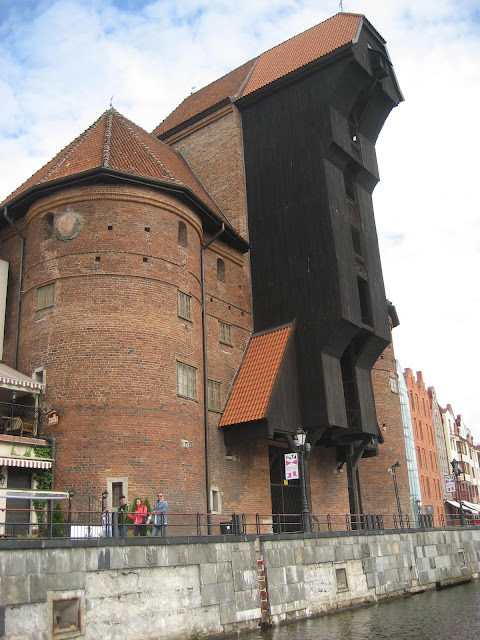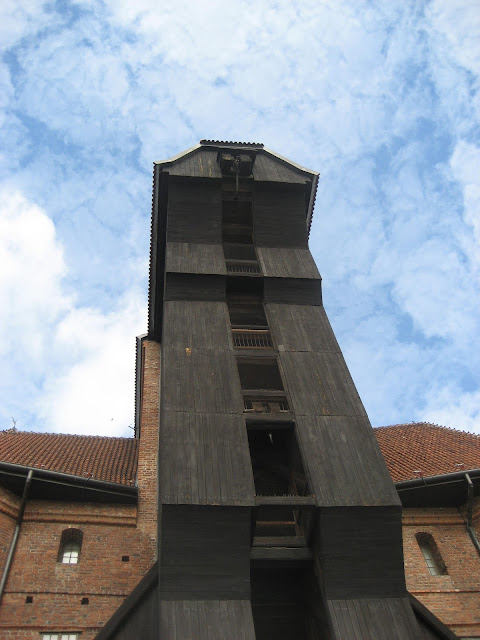July 22, 2012
We live on the western bank of the Motława River, south of the medieval city, and see a good deal of small boat traffic. Yesterday we noticed that a ferry passed by our windows around 9 am and again around 3 pm. After a little research, we discovered that this ferry goes to Westerplatte. Why would anyone want to go to Westerplatte? Stay tuned, I'll show you soon!
We embarked on the ferry less than a quarter of a mile from our apartment at Zabi Kruk. The ride cost 10 PLN per person ($3.00) and took almost two hours, but it was worth the time. Below are some of the sights along the way. It was a beautiful day for sightseeing, and it was the first day without rain!
Our ferry - the F5. Ferry in Polish is "prom"
Our building from the boat!
We are the apartment with the satellite dish on it (it doesn't work yet)
Almost to the old city
Gorgeous architecture
Creative, decorative down-spouts for the gutter systems.
The one on the far left is an owl, the middle is a cow, and the far right is....I'm not sure. Use your imagination!
View from the water of medieval town and the "Crane"
One of the most famous sights in Gdansk - the "Crane" or Zuraw (Polish) or Krantor (German).
It is a type of Treadwheel crane - built before 1366 and was burned by the Soviets in 1945, but the original brick structure remained. It has been beautifully restored and is a part of the Polish Maritime Museum.
Almost directly underneath the Crane!
I'm on a boat
Floating fish restaurant
Everybody look at me, I'm sailing on a boat
Shipyard Gdansk
Oil tanker
Ships being repaired at the shipyard
An oil rig being repaired
We noticed that once we stepped off the ferry onto the peninsula of Westerplatte, that there were lots of little bugs flying around. There were BILLIONS of LADYBUGS EVERYWHERE!
It was like being in an Alfred Hitchcock movie, except with ladybugs.
I kid you not, the walk ways were paved with smushed ladybugs.
I'm sure I'll find several in my hair when I take a shower later.
Ladybug in Polish is Boża Krowka, which means "God's little cow"
Westerplatte.
The very first shot that started World War II happened on this very peninsula.
The Nazi battleship Schleswig-Holstein was at the Port of Gdansk on a "goodwill visit."
The Polish cemetery on Westerplatte.
230 brave Polish soldiers fought against the Nazis here.
The surrendering officer, Major Henryk Sucharski, was allowed to keep his saber while being held captive, in recognition of the Pole's valor.
Sucharski's surrender on September 7, 1939
Photo courtesy of the Republic of Poland
The memorial statue at Westerplatte, in memory of the Polish defenders and the 55 Polish Post Office workers who were murdered by the Nazis on September 1, 1939.
NO MORE WAR
These remind me of the butterfly weed in Georgia - except purple instead or orange
For Euro 2012 soccer tournament, the city of Gdansk set up a series of ABC's of Gdansk next to the Museum of Amber (in Polish and English). I have photos of a few interesting ones here.
Above is information about F is for Fahrenheit
Fahrenheit's thermometer
Ancient local brew - J is for Joppe
R is for Reconstruction
S is for Solidarity
W is for Westerplatte
The detail on the buildings is just breathtaking! Lots of gold, bronze and copper
City Hall
After a long day on the ferry, we had a nice refreshing cocktail of bison grass vodka and apple juice.
(Can you see the long piece of grass in the vodka?)
I first had this drink with our friend Caitlin in DC at her infamous wintertime vodka party.
We used 1 part vodka to 1 part apple juice.
The final touch was the addition of fish-shaped ice cubes - a perfect ending to our day on the water!
Na Zdrowia!


















































